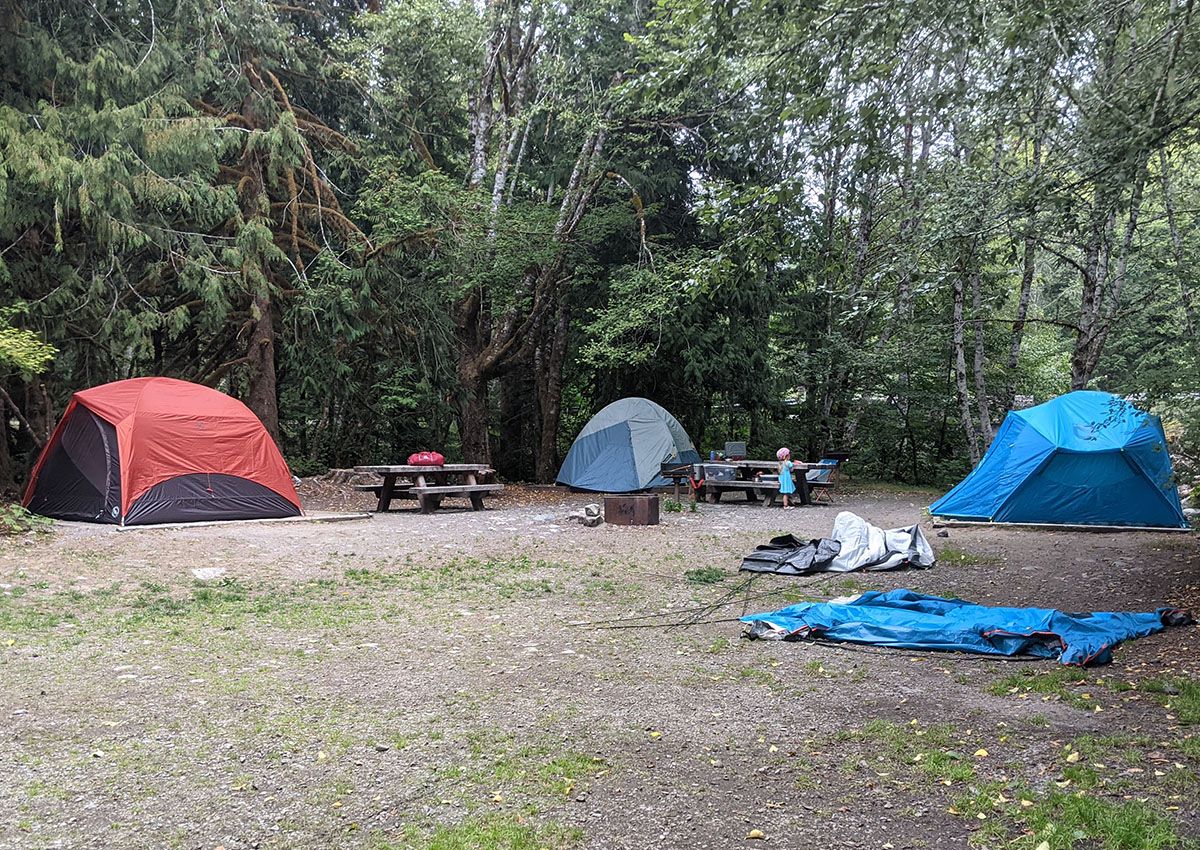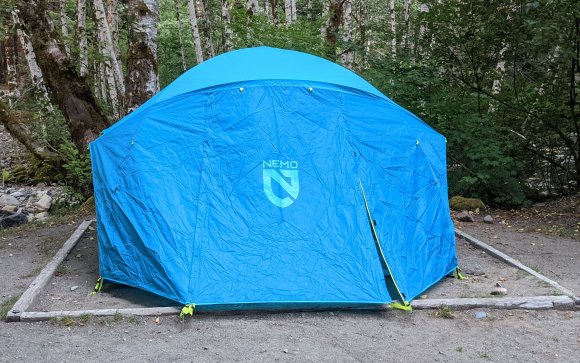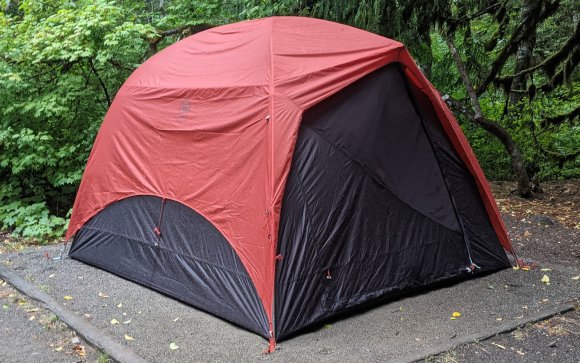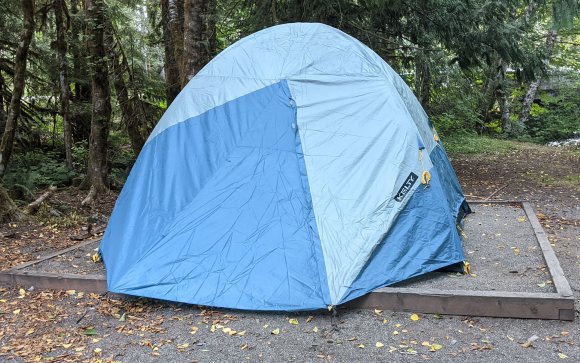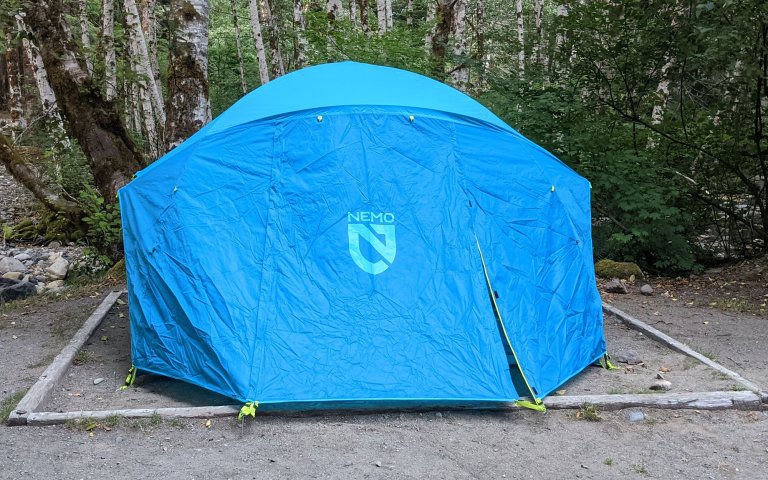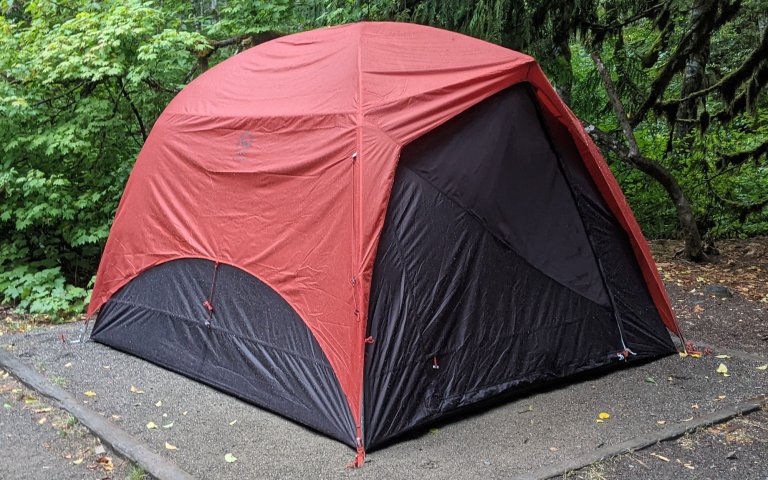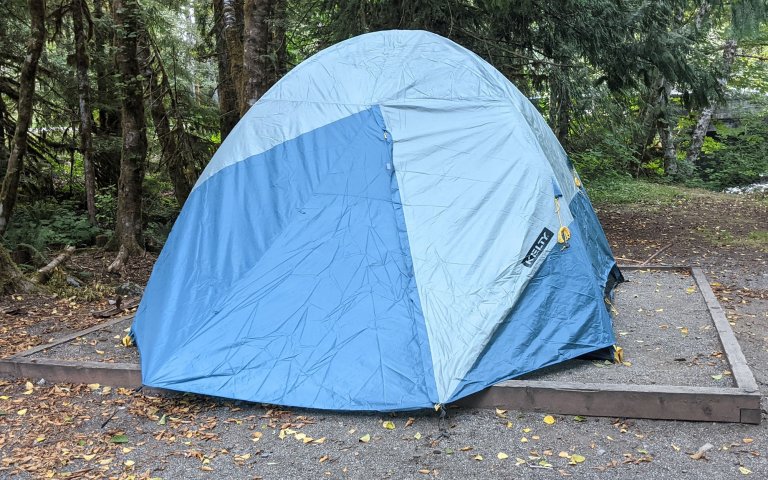We may earn revenue from the products available on this page and participate in affiliate programs. Learn More ›
If you’re thinking of taking your family camping for the first time, odds are you are looking for a 6-person tent. Despite its name, 6 person tents really work best for families of four (three, if you plan to have your smallest member in a pack and play). But with seemingly every outdoor brand having two or three models to choose from, how do you know which one has what it takes to see your family through a long week in the great outdoors? To find out, I set up five of the best 6-person tents from MSR, Kelty, Big Agnes, Decathlon, and NEMO on the eve of a thunderstorm to see which would come out on top.
- Best Overall: NEMO Aurora Highrise 6P
- Best Headroom: Big Agnes Big House 6
- Best Budget: Kelty Discovery Element 6
How I Tested the Best 6 Person Tents
Families out car camping have a short list of criteria for a 6-person tent. First, they need it to have plenty of space (and headroom) for up to four people (more than that should look at our reviews of the best 8-person tents). Second, it must be weatherpoof, able to not only slough off heavy rains and moderate winds, but also keep rain from dripping inside when you are taking the kid out for a midnight bathroom break. Finally, it needs to set up fast, and it can’t require more than one person to do it (parent #2 is kid wrangling). That’s it.

For this test, I rounded up five of the best 6-person tents on the market, from Big Agnes, Decathlon, Kelty, Big Agnes, and Nemo, and took them to a group campground off the Mountain Loop Highway in the North Cascades on a warm and sunny day. Fortuitously, my four year old’s preschool was closed for the week, so she came along. Even more fortuitously, the weather forecast was calling for a serious storm to break a 68-day dry streak that night.
Best 6 Person Tents: Reviews & Recommendations
Best Overall: NEMO Aurora Highrise 6P
Pros
- Easy one-person set up
- Plenty of vestibule space
- Great headroom across the interior of the tent
- Spacious floor design allows for different configurations
Cons
- Window closure mechanism is not as secure as it could be
- The blue interior color is very intense
Key Features
- Weight: 18 pounds, 10 ounces
- Floor Size: 100 x 120 inches (83.3 square feet)
- Headspace: 77 inches
- Doors: Two
- Poles: Four
I barely remember setting up the NEMO Aurora Highrise 6P Tent, which is about the highest praise I can offer. Insert the two longest poles through the crisscrossing sleeves, anchor them into the grommets at opposite ends, and secure a handful of tabs to pull the body taut. Two more poles go long ways across the tent to maximize headspace in the interior. Somewhere in the middle of this, I was called away from tent testing to read a chapter of Captain Underpants, but it was easy to just pick up where I left off when I managed to disentangle myself again.

Something that proved a real struggle with the best 8-person tents was putting on the rainflys single-handed (I’m 5-foot-5). This wasn’t an issue for the NEMO Aurora Highrise 6P Tent, or for any of the other 6-person tents I tested. All three of the tents I’m recommending color coded the corners of the rainfly to the corners of the tent, so once I had thrown it over the top, I could just walk it around until they were correctly lined up.
Something nice about the NEMO Aurora Highrise 6P Tent was that the two lengthwise poles attached to the rainfly, and were pretty taut (although not unnecessarily difficult to get into place), which helped to keep the rainfly off of the body of the tent. That ended up being extra important as the ground at my testing site turned out to be fairly difficult to stake into.
On the tent pads, the ground was firm but pliable—ideal for staking in—but everywhere else it was very compacted, and virtually impossible to get more than an inch in. This is a common scenario for car camping these days, so I was curious to see how the tents would handle the less than ideal staking situation. But I was less worried about my poor staking job with the NEMO Aurora Highrise 6P Tent because of the taut structure provided by the poles and fly alone.

Because of the security of the rainfly, the kiddo and I chose to spend the night in this tent. Well, that’s why I chose it: She liked the color. The bright glowing blue of the interior is perhaps the most memorable (and divisive) part of this tent. It’s very blue. I can see why the kid found it cheery. It does offer the impression of a bright sunny day, even as the clouds rolled in—PNWers may be reminded of an infamous Pemco commercial. Unfortunately, that means it also washes out all other colors. Personally, I might have chosen a different color if NEMO offered one (they don’t, currently).

I hung up one of the best camping lanterns (the chunky Goal Zero Lighthouse 600) from the loop at the center of the tent while the kiddo and I were getting set up for bed, leaving it at the lowest lumen setting while we slept overnight (“so it doesn’t get too spooky” per the 4-year-old). Somehow, she slept right through the night without issue. I, on the other hand, woke up to an unusually serious thunderstorm. Rain was dumping. The sky was booming. The camping lantern didn’t move an inch. The tent held taut against the rain. I spent some time considering the relative distance between our location and the actual lightning strikes (no camping tent is going to protect you from a direct hit), but once I was comfortable it wasn’t headed our way, it was easy to fall back asleep again. I just felt safe in this tent.

Beyond the blue coloring, my only other concern with this tent was the windows at the side. They close up from the inside with a simple toggle mechanism. While this wasn’t an issue with a straight up and down rainfall (the rainfly covers it by a few inches), in a storm involving both rain and wind, this could prove to be a failpoint.
Best Headroom: Big Agnes Big House 6
Pros
- Easy one-person setup
- Great headroom
- Entire tent fits squarely on a tent pad
- Great carry bag
Cons
- No vestibules (can be purchased separately)
- Expensive
Key Features
- Weight: 16 pounds, 14 ounces
- Floor Size: 100 x 118 inches (82 square feet)
- Headspace: 80 inches
- Doors: Two
- Poles: Three
If my 6-foot-3 husband had been on this testing trip, I’m pretty sure we would have ended up spending the night in the Big Agnes Big House 6. That’s because with an interior maximum height of 6 feet, 8 inches, he’d have been able to walk from door to door without stooping. Given how easy this was for 5-foot-5 me to set up, that’s an impressive feat of engineering.

One of the most unusual features about the Big Agnes Big House 6 is how it prevents rain from leaking in. Rather than opting for full coverage, the rain fly protects the top of the tent only. The doors have a waterproof covering that you can zip up from the inside. Typically, I would be worried that closing up the doors would increase the level of condensation inside the tent, but between the sheer amount of mesh (basically the entire ceiling) and the ceiling height, I think it’ll be OK for most environments.

The rainfly still isn’t my favorite design, however. First off, if you’re hanging around outside when it starts to rain, you’ll have to physically open the mesh doors to close up the waterproof panels, and then make sure that you’re zipping the corners tight to prevent rain intrusion. This is just more of a chore than simply zipping down the vestibule panels and heading back to relax with friends under one of the best canopy tents.
Second, there is no place to stash your muddy shoes or any other wet pieces of gear. If you live in a part of the country where it rains (as I do), then you’ll almost certainly want to invest in the additional vestibule. If you can get away without the vestibule however, it was nice to have a tent with 82 square feet of interior space that still fit easily on a tent pad. Despite my convenience concerns with the rainfly of the Big Agnes Big House 6, the tent was completely dry at the end of the overnight storm.
There were a few other features of the Big House 6 worth noting. It was surprisingly devoid of interior pockets for stashing odds and ends. I also didn’t love the stakes it came with: Big Agnes Dirt Daggers. While these stakes have excellent holding power (as my test of the best tent stakes showed), they aren’t designed to grip onto the larger loops of car camping tents, which makes them fussier to set up than the simple shepherd hook style stakes most of the other tents came with. I’d consider replacing (or supplementing) these with a hooked stake.

Finally I’d be remiss if I didn’t extol the convenience of the carrying bag. This backpack-style case has stow pockets for the stakes and poles built onto the inside. Given how often I have searched high and low for the separate pole or stake bags at the end of the trip, I was thrilled to see this feature.
Best Budget: Kelty Discovery Element 6
Pros
- Affordable
- Easy to set up
- Waterproof
Cons
- More claustrophobic interior space than others in my test
- Somewhat less headroom
- Rainfly is not taut unless staked out
Key Features
- Weight: 15 pounds, 13 ounces
- Floor Size: 107 x 120 inches (89 square feet)
- Headspace: 77 inches
- Doors: One
- Poles: Two
Spending $500 on a tent is hard. If you’re outfitting your whole family for the first time, it’s cost prohibitive. That’s why I was so pleased with how well the Kelty Discovery Element 6 handled my testing protocol. With just two crisscrossing poles, it was a cinch to put up. Given that the poles connect into sleeves at opposing corners (rather than fiddly grommets), it was arguably the easiest to set up. If you’re a first-time camper worried about the hassle of tent setup, this one is a great choice.

The heavier duty material being used for the Kelty Discovery Element 6 meant that the interior was unusually dark. If you’re camping with young children who still need daytime naps, that can be a boon, but it does mean that you’ll need to have a headlamp or camping flashlight on hand to see anything as soon as dusk settles in. At the end of the aforementioned overnight thunderstorm, this tent was completely dry on the interior.

Even though this tent technically has the same square footage as the Big Agnes Big House 6, it feels smaller due to the slope of the interior walls. The more square shape of the tent will also make for a slightly tighter squeeze when camping mattresses and sleeping bags are laid out side by side. A family of four can fit into this tent, but you’ll have a bit less flexibility of movement (an issue heightened by the single entrance).
The Rest of the Field
MSR Habitude 6
I had the poles in, but not the stakes or rain fly, on the Kelty Discovery Element 6 and the MSR Habitude 6 when my kid called me over needing help with her lunch. It was breezy, but nothing notable (unlike my test of the best 8-person tents). When I turned around, the Habitude was folded in on itself, the result of one of the pole sections at the center hub coming loose. Thinking I had simply missed connecting it completely the first time, I repositioned it and set it back up.
About 15 minutes later, when I had just finished getting up the body of the Big Agnes Big House 6 a second gust of wind swept through. This sent the MSR Habitude 6 cartwheeling into a nearby bush. (This wasn’t a serious wind, neither the Kelty Discovery Element 6 nor the Big Agnes Big House 6 moved at all.) When I pulled it out, one of the poles had cracked near the hub. Because of the location of the break (next to the pole hub) there was no way to jerry rig a fix in the field (MSR also did not provide a pole sleeve with this tent).

This was a disappointing and surprising result as I have become a big fan of the 4-person version of this tent, which employs a similar pole design. I’ve been using this tent for my non-testing family trips and haven’t had an issue yet (my kid is especially fond of assembling the shorter poles and then pretending they are swords). Once, I even carried the tent upside down about a hundred yards, to avoid having to unassemble and reassemble it when changing campsites within a campground. The tent survived this awkward transit, including me dropping it several times, without issue and I’ll be continuing to recommend it.
Things to Consider Before Buying the Best 6-Person Tent

Square Footage of the Best 6-Person Tents
As anyone who has bought a tent knows, the stated number of people a tent can fit and the actual number of people you would want to fit in a tent can vary significantly. And gear like sleeping pads and sleeping bags will quickly take up room. Check the dimensions of any tent you are considering to determine whether it will fit the family or group you will be camping with.
Ease of Set Up of the Best 6-Person Tents
The 6-person tents I looked at (mostly) only required one person to set them up, which can be a boon for families with small children. In those instances, speed is king. One rule of thumb that can help you determine how long it will take to set up a tent is to look at the number of poles. Typically, more poles will indicate a longer, more complicated set-up time, while a tent with fewer poles should come together relatively quickly.
Ceiling Height of the Best 6-Person Tents
One of the great joys of a 6-person tent is finally being able to stand up inside. The tents in my test had ceiling heights of around 6.5 feet, but there was also variability in whether this height was at a single point or spread along the spine of the tent.
Packed 6-Person Tents
A large footprint unfortunately also means more space taken up in transit. If you have a smaller car, consider choosing a 6-person tent with a smaller packed size.
FAQs
Families of six or more should opt for, at a minimum, an 8-person tent, if not a 10-person tent. “Six persons” typically refers to the number of sleeping bags that could literally fit in the tent. No walking space; no space for gear. (To make matters worse, the size of said persons in the tent can vary wildly.) 6-person tents are appropriate for families of four.
Tents that are made out of nylon with stainless steel poles will last longer than other materials. It’s also worth looking at the best canvas tents if you’re willing to trade heavier materials and a more complicated setup for a more durable final product.
The most stable tent shape can vary from climate to climate. For example, a tube-shaped tent can handle heavy winds that come from one direction great, but tend to suffer if they are coming from multiple directions. Similarly, A-frame shapes are champs at handling heavy rain (and even snow) but result in significantly less usable floor space as a result. Rather than look for a single tent shape that can do it all, consider what kinds of weather conditions you are most likely to encounter, and look for a tent shape that can handle those appropriately while also maximizing living conditions.
Final Thoughts on the Best 6-Person Tents
The right 6-person tent can see your family through many seasons of camping, from when the kids are just getting started exploring the campground up through when they are teenagers. The tents I looked at were impressive for their ease of set up, their weather resiliency, and interior height. Importantly for camping families, they also mostly fit onto the tent pads now common in campgrounds.
- Best Overall: NEMO Aurora Highrise 6P
- Best Headroom: Big Agnes Big House 6
- Best Budget: Kelty Discovery Element 6
